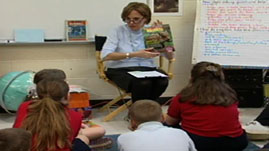Teachers' Domain - Digital Media for the Classroom and Professional Development
User: Preview




Teacher Karen Miller (Roby Elementary, Bullitt Co., Kentucky) models for her third grade students how readers ask themselves questions before, during, and after reading to improve comprehension. She also demonstrates how questions differ according to genre. After the whole-class lesson, students apply the strategy to their choice of text.
Teaching students to ask their own questions improves their active process of text and their comprehension. By generating questions, students become aware of whether they can answer the questions and if they understand what they're reading. (National Institute of Child Health and Human Development. (2000). Report of the National Reading Panel. Teaching children to read: an evidence-based assessment of the scientific research literature on reading and its implications for reading instruction. Retrieved May 5, 2011, from http://www.nichd.nih.gov/publications/nrp/smallbook.htm.)
Teacher Karen Miller (Roby Elementary, Bullitt Co., Kentucky) models how readers ask themselves questions as they read to improve their comprehension. She uses examples from multiple genres to demonstrate how questions differ according to genre. Using a feature article from a children's magazine, Karen writes questions on post-it notes to place directly on the text. She models the questions that arise by thinking aloud as she reads the cover, the inside text feature,s and the article. After the whole-class lesson, the students apply the strategy to their choice of text.
This video was originally part of the multimedia professional development resource, Literacy Strategies in Action produced by KET in 2006 in collaboration with the Kentucky Department of Education.
Describe the questions you could model for your students before reading? During? After?
What characteristics of highly effective teaching and learning do you observe?
Kentucky Department of Education: Characteristics of Highly Effective Teaching and Learning
 Loading Standards
Loading Standards